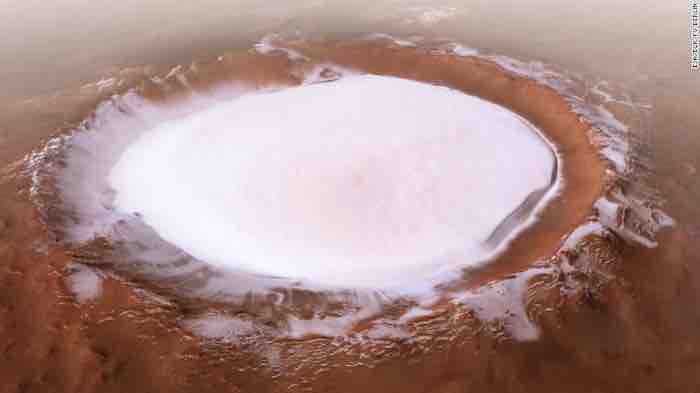
The Red Planet (Mars) is not going to turn into another Blue Planet (Earth) any time soon and a sizable reservoir of water on Mars is still elusive

Who would have guessed that ice abounds on planet Mars?
That’s what made the news in recent days. There’s hardly any news service that did not cover the new finding by the European Space Agency’s (ESA) Mars Express mission, 15 years after it launched in 2003. Bob McDonald of the CBC radio show Quirks & Quarks even claims “A lake of water was found on Mars—and may be the first of many.”
The ESA’s message is titled “Mars Express gets Festive: A Winter Wonderland on Mars.”
Finally ...
... the Mars Express mission came through, after exactly 15 years of searching, with the news of a crater, called the Korolev crater, an 80 mile wide crater on the planet that is covered by a white surface as shown nearby. It sure looks impressive.
As Wikipedia states “Mars’s Korolev crater is located on the Planum Boreum, the northern polar plain which surrounds the north polar ice cap, near the Olympia Undae dune field. The crater rim rises about 2 kilometers (1.2 mi) above the surrounding plains. The crater floor lies about 2 kilometers (1.2 miles) below the rim, and is covered by a 1.8 kilometers (1.1 mile) deep central mound of permanent water ice...” [emphasis added]. Clearly, it’s claimed to be “water ice” not some other kind of ice.
The Korolev crater on Mars (there is also a crater with that name on the Moon), is close in latitude to the Martian North Pole, a place with a seasonal layer of Dry Ice. That’s not surprising as the atmosphere of Mars consists of about 96% carbon dioxide, 1.93% argon and 1.89% nitrogen along with traces of oxygen and water (Wikipedia).
When it gets really cold, like around Minus 100 C (Minus 150 F), not much liquid is to be found anywhere, neither on Earth nor on Mars. In fact even the gas carbon dioxide (CO2), making up a mere 0.04% of the atmosphere on Earth vs. 96% on Mars, is a white solid material, commonly known as Dry Ice.
Dry Ice
Many people may have seen Dry Ice (DI), without recognizing it. For example, it is widely used as a temporary refrigerant in the transport of parcels with frozen perishable goods. It is commercially available in blocks, slabs and granules from various suppliers, like https://www.dryiceandgases.com/ . We’ve used it on many occasions to keep some frozen foods from thawing and getting spoiled. Of course, that only works for a limited time, i.e. until the CO2 has entirely sublimed into the thin air.
My first experience with DI, however, dates back to my childhood, several decades earlier. It was in my early teens when a public boxing match in the town square was announced. I didn’t want to miss the event and it was only a short walk to the venue. As the competitors got ready, just prior to having the gloves put on, they were holding pieces of a white material (I thought water ice) in their hands. When they discarded the white stuff I got hold of a small piece and soon realized that it wasn’t just simple ice, say at a few degrees below freezing. It was something else that started to “burn” my skin.
The pain was real but the sensation of burn was really the sensation of a developing frostbite. No wonder, it was solid DI at its sublimation temperature (at the prevailing atmospheric pressure) of approximately MINUS 60 C (MINUS 75 F)! Whether stemming from a source of high heat or extreme cold, the skin perceives it as a “burn.”
Mars and Water
But let’s go on and talk more about Mars, where you also could get a “burn,” especially when exploring the dark (night) side. There, temperatures as low as MINUS 100 C prevail.
If the Korolev crater on Mars really contained water ice, it stands to reason that there would be more than only traces of water in its atmosphere. After all, the other half of Mars, exposed to the sun warms up to a comfy 80+ F (30 C). Furthermore, the polar “ice” caps on Mars wax and wane with the seasons, similar to what is observed on the Earth, except for one important difference. On Mars, the caps are not water ice but dry ice (frozen CO2). With that in mind, it’s not unlikely that the Korolev crater is actually filled with solid carbon dioxide too.
The Red Planet (Mars) is not going to turn into another Blue Planet (Earth) any time soon and a sizable reservoir of water on Mars is still elusive.

Dr. Klaus L.E. Kaiser -- Bio and Archives | Comments
Dr. Klaus L.E. Kaiser is author of CONVENIENT MYTHS, the green revolution – perceptions, politics, and facts Convenient Myths
Please adhere to our commenting policy to avoid being banned. As a privately owned website, we reserve the right to remove any comment and ban any user at any time.
Comments that contain spam, advertising, vulgarity, threats of violence and death, racism, anti-Semitism, or personal or abusive attacks on other users may be removed and result in a ban.
-- Follow these instructions on registering:
Bagikan Berita Ini















0 Response to "Ice on Planet Mars - Canada Free Press"
Post a Comment